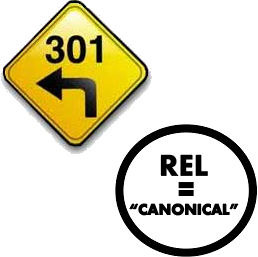 To start with, let me apologize for the title of this piece. It’s a little misleading – not because it isn’t about 301s, though. I only wish people would ask that question! No, unfortunately, far too often as I am performing website SEO audits, I see people using 301s incorrectly. We’ll often see people using canonical references the wrong way, too.
To start with, let me apologize for the title of this piece. It’s a little misleading – not because it isn’t about 301s, though. I only wish people would ask that question! No, unfortunately, far too often as I am performing website SEO audits, I see people using 301s incorrectly. We’ll often see people using canonical references the wrong way, too.
“What’s the difference?” you may ask.
Well, even though Google’s Matt Cutts says there’s no difference between the slight amount of link juice lost whichever of the two you decide to use, he does suggest using a 301-redirect whenever possible. The reason he gives is that all browsers understand what a 301 is. That’s not the case with a canonical reference. Google, in fact, says that they take it as a “strong suggestion” but that they, too, might ignore canonicals, meaning that you may occasionally see pages with canonical attributes appearing in search results.
First off, I guess I should define what each one of these things are and what they are supposed to be used for …
301 Re-Direct: A 301 is used to tell search engines that a page no longer exists and that it has permanently been moved to a new location. A 301 should not be used for a page that is only temporarily unavailable.
Canonical: rel=”canonical” is used when there are multiple versions of the exact same or very similar page on a website. Placing this tag in the header of a page tells search engines which version of the page should be indexed and which one(s) should be ignored as duplicates. As you should be aware, duplicate content is frowned upon by Google and could cause a drop in search engine rankings. Canonical references are generally used for multiple URL’s that really indicate the same page (i.e. http://mywebsite.com, http://www.mywebsite.com, http://mywebsite.com/index, etc.). A canonical reference to the main page should also be used when there are different versions of the same page that are created by sort options (sort by price, sort by rating, sort from A-Z, etc).
That should be clear enough, but there are some “dos” and “don’ts” associated with using 301s or canonical references …
301 Dos
- Do use a 301 for any page that is permanently being moved.
- Do use a 301 to re-direct pages that are returning 404 errors, assuming there is a relevant page on your website that replaces or is close to the content of the non-existent page.
301 Don’ts
- Don’t use a 301 to redirect every page of an old website to a new domain’s home page. Each page should have a corresponding page that it is re-directed to on the new website.
- Don’t use a 301 for pages that deal with very current or short-lived content. It takes awhile for Google to pick up a 301 re-direct and if it is a page that will not exist for long or is one announcing a last-minute campaign, you’re better of not re-directing it.
- Don’t use a 301 if you are temporarily moving content to another URL but will be moving it back to its original URL. You should use a 302 re-direct for temporary moves.
rel=”canonical” Dos
- Do use canonical references when you have identical or practically identical content on pages that you need to keep on the website, whether you created the content or your site software created it.
- Do use rel=”canonical” when you have two domains with the same content but you need to keep both of the domains active (like when you are moving a website and need regular visitors to still find the old site during the transition).
rel=”canonical” Don’ts
- Don’t use rel=”canonical” unless it is really a duplicate page or a very substantial part of the content is the same. If only a few lines of text here and there are the same, it is best to leave the page alone.
- Don’t use rel=”canonical” to refer to the first page of a multi-page article. Each page has its own unique content, after all.
- Likewise, don’t use rel=”canonical” for categories that are broken up into multiple pages. Instead, the newer rel=”next” and rel=”prev” tags should be used. This tells search engines that the content is all to be considered one long page, even though it is broken into smaller pages.
I hope this helps to clear up an issue that so many people find confusing. If you have no idea what I am talking about or don’t know how to implement these things, you should probably contact an SEO professional. We’d be happy to help!

